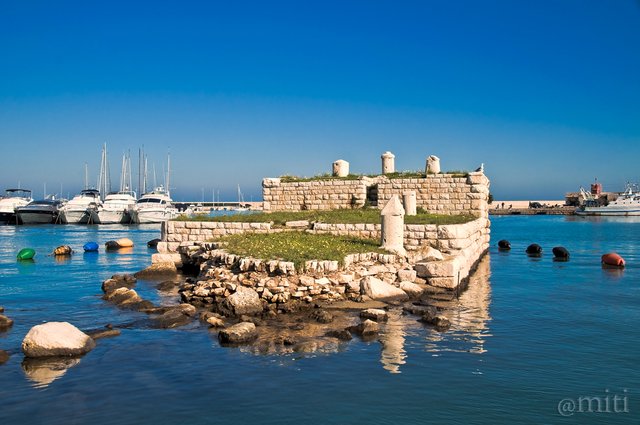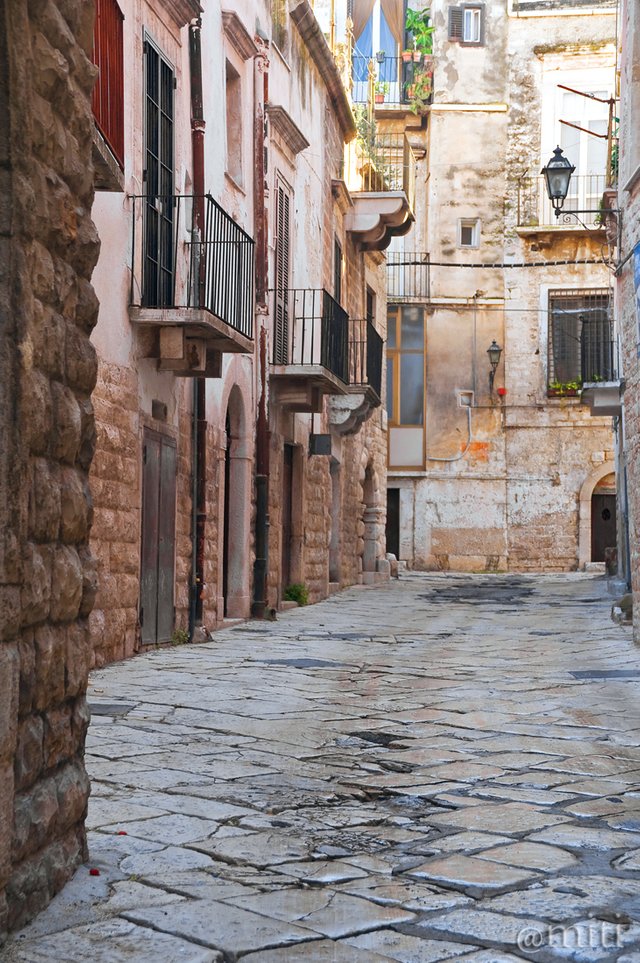A Journey through Italy: one photo every day #140 - BISCEGLIE [ENG/ITA]

The area called "La Cassa" (Author's photo - All rights reserved)
L'area conosciuta come "La Cassa" (Immagine dell'autore - tutti i diritti sono riservati)



Ciao a tutti,
questo è un viaggio attraverso l'Italia. Posterò una foto al giorno con una brevissima descrizione. Spero vi piaccia!

Bisceglie è una città nella provincia della BAT (Barletta / Andria / Trani), nella regione meridionale italiana della Puglia. È famosa per la bellezza della sua costa intervallata da insenature e mare limpido ed è stata premiata con la Bandiera Blu per la qualità dell'acqua del suo mare.
Bisceglie è stata abitata sin dal Paleolitico. Le numerose scoperte archeologiche sono sopravvissute relativamente intatte fino ad oggi, come i dolmen - monumenti megalitici con funzione di sepolcro-altare.
Il più famoso di essi, il dolmen della Chianca, è situato a circa 5 km dal centro abitato.
Numerosa è anche la presenza di Casali, piccoli agglomerati abitativi, spesso fortificati, i cui abitanti, più tardi, affluirono verso il borgo medievale costruito sul mare e dotato, ad epoche diverse, di Torri di guardia e di difesa, di un Castello (epoca normanna) e di mura e di bastioni (epoca aragonese).
Il nome potrebbe derivare dal latino Vigiliae, che era usato per l'avamposto militare circondato da mura e difeso da sette torri sulla Via Traiana, o in alternativa dal non-classico latino Vescellae che significa area boschiva.
Le prime fortificazioni della città furono ispirate dal Conte di Trani nel 1060. Della Torre Maestra e del Castello, l'ex torre di avvistamento alta 27 metri, entrambi costruiti in epoca normanna, mentre di quest'ultima costruita probabilmente dal conte normanno Pietro I, rimangono solo tre maestose torri, parte delle mura originali e la chiesetta di San Giovanni in Castro.
Il periodo più oscuro della storia di Bisceglie, tuttavia, fu durante l'oppressione e il dominio spagnolo, riscattati dalla conseguente dominazione francese.
Il porto pugliese di Bisceglie è incastonato ai piedi della città antica all'interno di due antiche strade (La Marina e Porto) in cui un tempo scorrevano due vecchi fiumi.
I Normanni avevano colto la particolarità della costa di Bisceglie, facendo del porto attuale la loro residenza sul mare. Altri segni del traffico intenso del porto sono manifestati dal grande anello di pietra che ora forma il bastione di S. Martino, a cui le navi erano probabilmente legate durante il periodo borbonico.
Nel 1700 fu costruito l'attuale molo vecchio, ad est del bacino portuale. Al centro del porto medievale di Bisceglie si trova una piccola area denominata "La Cassa", con un punto su cui sono presenti grossi blocchi di pietra: è possibile che ciò costituisca la parte terminale di un ponte realizzata (o parzialmente costruita ) nel periodo svevo.
Preziose sono anche le chiese in stile romanico-pugliese, tra le quali emerge la bellezza della Cattedrale da cui partono e arrivano tutte le strade della città antica sia dal mare (al porto) e dalla campagna (fuori le antiche mura, che sono ancora in gran parte visibili).
La Cattedrale di San Pietro fu costruita su una precedente chiesa nel 12 ° secolo e consacrata nel 1295, per conservare i resti dei tre santi Mauro, Sergio e Pantaleone, martiri del 117 d.C., i cui corpi furono rinvenuti a Sagina nel 1167.
La chiesa di Santa Margherita fu fondata nel 1197 da Falco Falconi, un giudice di Enrico VI, un bell'esempio di architettura romanica pugliese, ad una sola navata, dove custodiva una preziosa urna in alabastro (ora è nel museo archeologico) e due dipinti bizantini su legno raffiguranti Santa Margherita e San Nicola.
La chiesa di S. Adoeno, una delle più antiche della Puglia, dedicata a San Adoeno Dado, vescovo di Rouen e protettore della Normandia, fu costruita secondo la tradizione dai soldati normanni stessi nel 1074. Anche se in origine in stile romanico, è stato ristrutturato nel periodo barocco.
Oggi Bisceglie è un vivace centro agricolo e commerciale, con un entroterra coltivato a vigneti, mandorli e ulivi, e una costa straordinaria di baie, promontori e grotte marine.
Cosa vedere: il centro storico, la cattedrale di San Pietro, la chiesa di Santa Margherita, la chiesa di S. Adoeno, la chiesa di San Luigi, la Torre Maestra e il Castello, le bellissime baie nella zona di Pantano-Ripalta, i misteriosi Dolmen (Albarosa, Chianca, Giano, Frisari, Paladini), la piccola area denominata "La Cassa".

Hello everyone,
I began a Photo Journey through Italy. I will post one photo every day with a little note of explanation. I hope you like it!

Bisceglie is a town in the province of BAT (Barletta/Andria/Trani), in the southern Italian region of Puglia. It is famous for the beauty of its coastline interspersed with coves and limpid sea and it was awarded the Bandiera Blu (the “blue flag”) for the quality of sea water.
Bisceglie has been inhabited since the Paleolithic. The numerous archaeological discoveries have survived relatively intact until today, such as the dolmens - megalithic monuments having a burial-altar function.
The most famous of these, the dolmen of Chianca, is situated about five kilometers from the centre of the town.
There are also many Casali settlements, often fortified. The inhabitants of these Casali, later, would move towards the medieval stronghold built on the sea and equipped with Defence Towers from the Aragonese Period.
The name may derive from the Latin Vigiliae, that was used for the military outpost surrounded by walls and defended by seven towers on Via Traiana, or alternatively from the non-classical Latin Vescellae meaning forested area.
The town’s first fortifications were instigated by the Count of Trani in 1060. The Torre Maestra and the Castle, the former a sighting tower 27 meters high, both built in Norman times, while of the latter, built probably by Norman count Peter I, are extant three majestic towers, part of the original walls and the small church of San Giovanni in Castro.
Bisceglie’s darkest period in history, however, was during Spanish oppression and rule, redeemed by the ensuing French rule.
The Apulia port of Bisceglie is imbedded at the feet of the ancient city within two ancient streets ( La Marina Street and Porto Street) in which once flowed two old rivers.
The Normans had grasped the particularity of the Bisceglie Coast, making of the present port their residence on the sea. Other signs of the intense traffic of our port are dated by the large stone ring which now form the bastion of S. Martino, to which the ships were probably attached during the Bourbon Period.
By 1700 the present molo vecchio was constructed, in the east of the port basin. At the centre of the Medieval port of Bisceglie there is a small area called ‘La Cassa’, with a point on which there are large blocks of stone: it is possible that this formed the end part of a bridge carried out (or partially built) in the Swabian period.
Precious are also the churches in romanico-pugliese style, from among which emerges the beauty of the Cathedral from which depart and arrive all the roads of the ancient city both from and to the sea side (at the port) and from the countryside (outside the ancient walls, which are still largely visible).
The Cathedral of San Pietro, built on a previous church in the 12th century and consecrated in 1295, to preserve the remains of the 3 saints Mauro, Sergio and Pantaleone, martyrs in 117 AD, whose bodies had been found in Sagina in 1167.
The church of Santa Margherita founded in 1197 by Falco Falconi, a judge of Henry VI, a beautiful example of Apulian Romanesque architecture, with only one nave, where a precious alabaster urn wa kept (now it is in the Archaeological museum) as well as two Byzantine paintings on wood representing Santa Marguerite and St. Nicholas.
The church of St. Adoeno, one of the most ancient in Apulia, dedicated to Saint Adoeno Dado, Bishop of Rouen and protector of Normandy, was built according to the tradition by the Norman soldiers themselves in 1074. Though originally in the Romanesque style, it was refurbished in the Baroque period.
Today Bisceglie is a lively agricultural and trading center, with a hinterland cultivated with vineyards, almond and olive trees, and a remarkable coastline of bays, promontories and sea grottos.
Thing to see: the Historical centre, the Cathedral of San Pietro, the church of Santa Margherita, the church of St. Adoeno, the church of St. Luigi, the Torre Maestra and the Castle, the beautiful bays in the Pantano-Ripalta area, the mysterious Dolmens (Albarosa, Chianca, Giano, Frisari, Paladini), the small area called ‘La Cassa’.

| Tipo di foto / Category | Paesaggio / Landscape view |
| Esposizione / Settings | 1/250 sec, ISO 200, f/10 |
| Camera | Nikon D5000 |
| Lente / Lens | Tamron SP 17-50mm f/2.8 XR Di II LD |
| Filtro / Filter | Polarizzatore Hoya / Hoya Polarizing filter |
| Cavalletto / Tripod | Manfrotto MKC3-P01 |
| Località / Location | Bisceglie (BAT), Italia |
| Software | Photoshop / HDR |


Alleyway in the historical center (Author's photo - All rights reserved)
Vicolo del centro storico (Immagine dell'autore - tutti i diritti sono riservati)
Congratulations, Your Post Has Been Added To The Steemit Worldmap!
Author link: http://steemitworldmap.com?author=miti
Post link: http://steemitworldmap.com?post=a-journey-through-italy-one-photo-every-day-140-bisceglie-eng-ita
Want to have your post on the map too?
Wow super post i love your post i am become your fan and me also love photography i want buy a camera please tell me which camera is best for photography
There's no such thing as good or bad camera, it's all what you do with it.
Nice captured, i think bro you are a authentic photographer carry on dear, always with you
Posted using Partiko Android
Thanks for kind words.
Welcome
Posted using Partiko Android
Wow really amazing photos, thank you for sharing
You're welcome.
really makes your photography awesome. thanks.@miti
;-)
Really such a very impressive places,Water looks so cool,Water looks so beautiful,Amazing place in the water,Many ships in the water,Italy is my favourite country,Very wonderful architecture of this building,Building looks so beautiful,Really very nice photography,I really like your photography,Thanks for sharing,
You're welcome.
Ciao Carlo piacere, aspetto che non ti avrai perso di assaggiare dei celebri "sospiri " della cittá! ;)
Greetings friend miti ... how are you? ... It must be a beautiful city. The area called "La Cassa" I like very much! :) Happy weekend...
Wow!! Amazing place and nice photography. After looking at your picture I want to go Italy. Thanks, @miti to give nice picture.
Davvero splendido anche qui!!! :-D